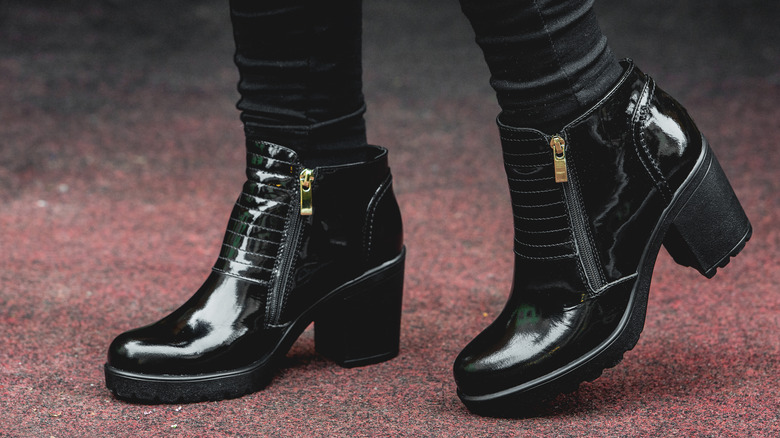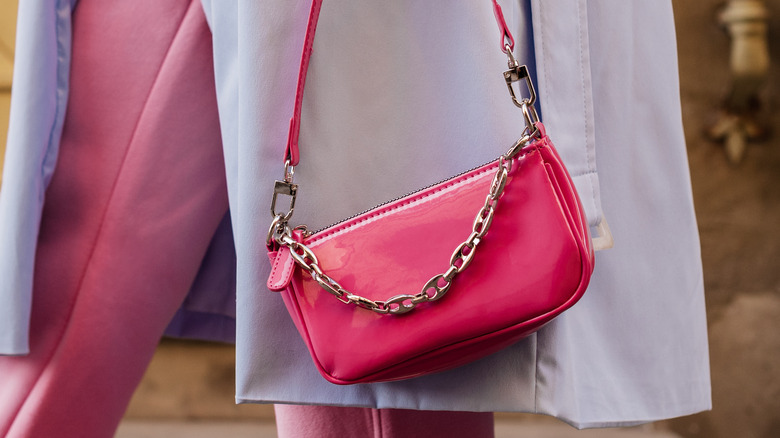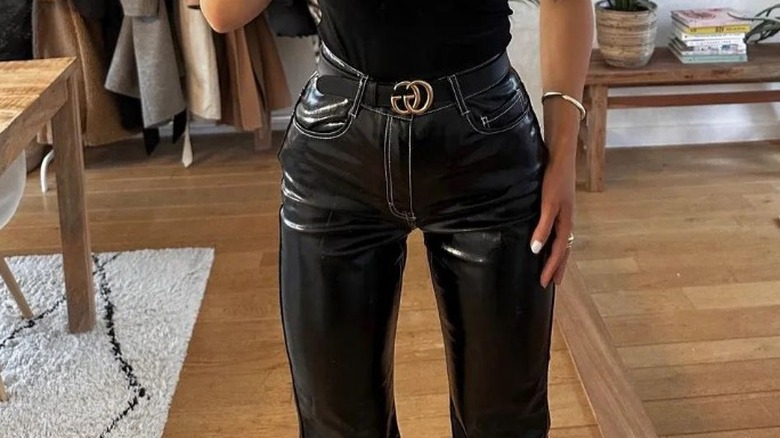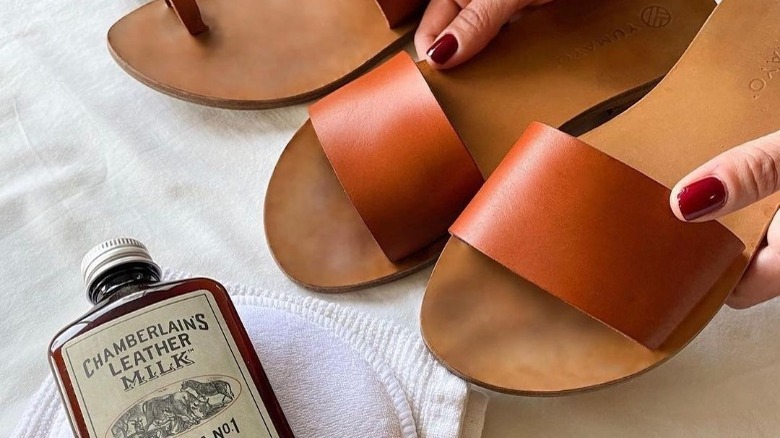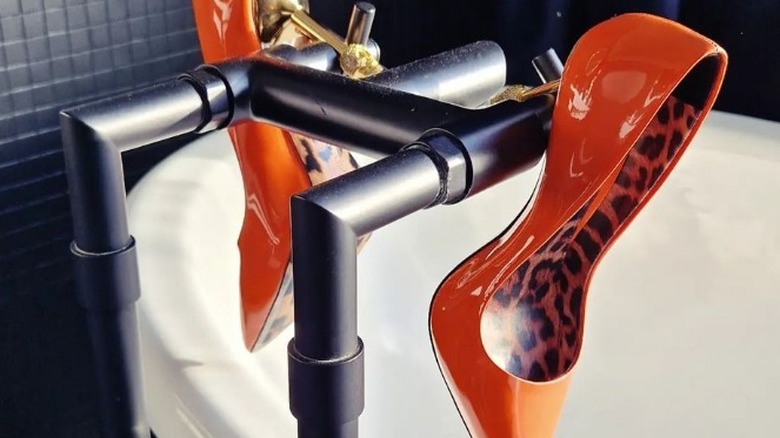Tips For Getting Unsightly Scuff Marks Out Of Your Patent Leather Goods
There's something about patent leather that screams high fashion. Made from top-grain cow or cattle hide, patent leather has a sleek finish befitting high-cost and high-quality garments and accessories. Valentino, Christian Louboutin, Chanel, and Hermes are some iconic brands that have been using patent leather in the making of their luxury handbags and clothes since the initial days of their businesses. Not only do patent leather goods boast a high-gloss surface and a luxury feel, but they're also water-resistant and super durable, Liberty Leather Goods points out.
If you're looking for wardrobe staples that guarantee versatility and resale values, look no further than patent leather pieces. "Leather is an investment purchase that has enduring appeal, and with wear, becomes a second skin," says Heather Gramston, head of womenswear buying at Browns, to Vogue. The only problem with this fabric is that its glossy surface makes it highly vulnerable to scratches. It's not unusual to come home after a night of partying to find scuff marks all over your high-shine designer handbag.
Scuff marks might seem trivial in the grand scheme of things, but they can take away from the inherent luxe of patent leather goods. Getting unsightly scuff marks out of your fancy leather shoes or designer handbags can have a significant impact on their appearance and value. But how can you remove scuff marks and restore glam to your patent leather goods?
Use soap and water
Who would have guessed soap and water can be a game-changer when it comes to saving scuffed leather surfaces? According to Bailey Carson from the cleaning business Handy, all you need to remove unsightly scuff marks from patent leather is a soft cotton washcloth dampened with mild soap and a small amount of water. "You don't want to soak it, just get it a bit damp," Carson tells Cosmopolitan. "Wipe down the patent leather and then, with a soft polishing cloth, dry it right after." Once you're done, let the good air dry for 24 hours in a cool and dry place at room temperature, then apply a leather conditioner to it to preserve the shine and keep the fabric supple.
Beware: you should never dry leather under direct sunlight or with a dryer. Exposure to sunlight and heat can damage a massive amount of chemicals in the fabric and fade its color, per Chamberlain's Leather Milk. Storing your patent leather item in a soft and breathable dust bag is a good way to protect it from light, moisture, and dust as well as color transfer.
Use nail polish remover
Turns out, an acetone-based nail polish remover can be as effective in removing scuff marks as it is at taking off the coating on your nail. You can get this household staple at any drugstore at a dirt-cheap price. To remove scuff or scratch off your leather goods, apply a little nail polish remover to a cotton pad or a q-tip and lightly rub it against the marks that need treating in small, repetitive motions until the scuffs fade away, according to YouTuber Joy. Once you're done, dab a dry and clean cloth on the treated marks to remove any nail polish remover residue.
However, using a nail polish remover on patent leather might cause the fabric's shiny and water-resistant coating to dry out and break down, Favored Leather warns. This will cause the fabric to be more vulnerable to scuffs and stains. To prevent the chemicals in the product from corroding the coating, take care to use it in small quantities and clear away any residue after use.
Use white vinegar
Good old white vinegar also goes a long way when it comes to removing unsightly scuff marks. First, lightly dip a cheesecloth or a pad into white vinegar diluted with water, and lightly dab scuff marks with the solution. Afterward, use a separate clean cloth to lightly buff at the treated marks. Chris Moore, owner of Artbag, explains to Martha Stewart: "The acidity in vinegar makes the scratch swell and settle back into a similar pattern." Although white vinegar cannot make the marks go away, it can make them look less noticeable. Additionally, white vinegar can help eliminate any unpleasant odor from your leather goods.
To make sure that the formula works on your patent leather item, conduct a spot test on a less obtrusive area and observe how it reacts first. If the area does not dry out or bleed dyes, you can proceed to work on a wider section of the leather, The Jacket Maker points out. Once the leather surface is dry, treat it with a leather conditioner to restore shine and smoothness.
Use leather conditioner
When it comes to fixing rough marks on patent leather, swap leather cleaners for deep treatment leather conditioners. According to Favored Leather, using a leather cleaning on scuffs and scratches can crack the leather, discolor the fabric, and make it susceptible to mold. Leather conditioners are effective in nourishing leather and restoring to it the natural oils and waxes lost due to scuffing. Plus, they work well on all types of leather.
For a start, make sure the leather item is clean and dry when you use a leather conditioner on it, per Vintage Leather. Instead of dabbing the solution directly on the fabric, apply the solution to a soft and clean cloth or a sponge. Liberally spread the cloth in a circular motion over the entirety of the leather item, and give it a few minutes to soak in the nutrients. Then, use a second clean cloth to buff at the marks and let the item air dry once you're done.
Use petroleum jelly
You can also use petroleum jelly to cover offending scuffs, scratches, and minor tears on your patent leather goods. While many people are skeptical about the use of Vaseline on leather, Leather Insights argues that this slimy substance can eliminate small and light scuff marks due to its ability to replenish lost oils in the leather fibers and make the fabric supple again. Petroleum jelly can also help enhance the color and shine of patent leather.
To safely use petroleum jelly on patent leather goods, take a dime-sized amount of Vaseline on your finger and distribute it evenly to the entirety of the leather surface, according to Magic of Clothes. Keep in mind that petroleum jelly can leave behind an oily residue on the leather surface and make it easier for the item to trap dirt, so make sure you apply it sparingly. Then, use a soft, clean cloth to lightly and evenly rub the solution into the leather. After a couple of minutes, use a second dry cloth to remove product residue from the leather surface.
Use olive oil
Olive oil is another quick and affordable way to hide shallow scuff marks on the leather surface. To start, apply a tiny amount of olive oil into a microfiber cloth and lightly rub it over the scuff marks, advises cleaning expert Bailey Carson (via Cosmopolitan). Make sure you don't apply too much pressure on the scratched leather surface, lest its condition worsen. Then, let the solution sit for 15 to 20 minutes before using another clean cloth to remove the excess oil.
You can repeat the process twice daily if needed, but make sure you don't go overboard with the process, LeatherProfy warns. Leather is highly permeable, and once the oil seeps into the leather, it ends up spreading throughout the fibers and develops oil spots. Too much of any oil is bad for the longevity of leather — so use sparingly and know when to stop. If the leather surface has sustained deep and extensive scuff marks, you might want to consult a leather repair specialist for help.

